This post may contain affiliate links which means I will get a commission if you make a purchase at no additional cost to you. As an Amazon Associate I earn from qualifying purchases. Please read my disclosure for details.
Have you ever had ewedu soup? You’re missing out on an amazing Nigerian dish if you haven’t. Whether you’re looking to satisfy your hunger or boost your health, this traditional Nigerian soup is an authentic and delicious choice.

WANT TO SAVE THIS RECIPE?
Ewedu soup is a popular delicious-tasting soup made from jute leaves. This viscous soup is a favorite among the Yoruba people of Nigeria. It is commonly served with amala (a type of yam/cassava flour).
Ewedu is very nutritious and has a slimy texture similar to okra soup. Making ewedu is super easy to do, and it cooks in a very short time.
What Is Ewedu Leaf?
Ewedu leaf, known as jute leaf in English, is a type of leafy vegetable found in the tropic and subtropical regions of the world like Africa and Asia.
It is a generally flavorful and tender leaf that has slightly toothed edges. Botanically, they are known as Corchorus Oliturus.
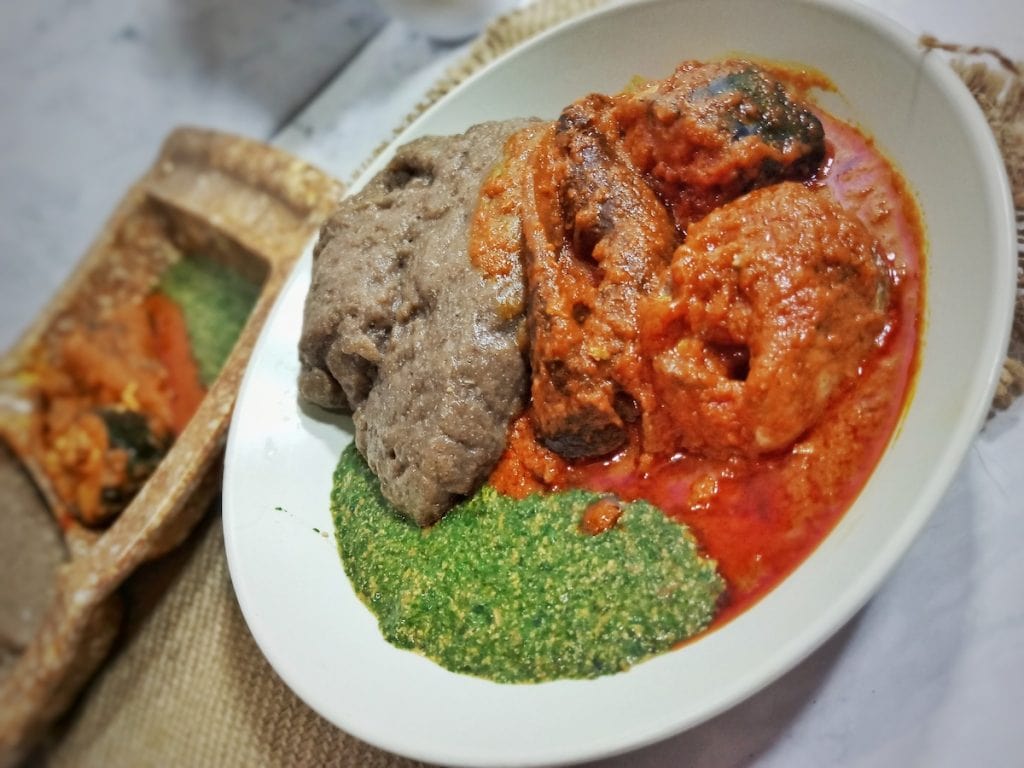
They add a distinct flavor to food and act as thickeners in soups, stews, and sauces. Depending on the region and the cuisine, ewedu leaf can also be called; Lalo, Saluyot, Molokai, Mulukhiyah, Ayoyo, or Bai Po.
They are not only known for their culinary purposes but also for their medicinal properties in West Africa (see health benefits below).
What Does Ewedu Soup Taste Like?
According to the Chicago Tribune, ewedu soup (jute leaf soup) tastes like spaghetti sauce with a little cheese.
It is naturally herbaceous because it is made mainly from fresh jute leaves. The seasonings added to the ewedu soup make it savory and flavorful.
What Are The Health Benefits Of Ewedu Leaf?
Boost Immune System
Ewedu leaf contains vitamin C that, boosts the immune system to fight infections, heal wounds, reduce inflammation and maintain healthy skin. A cup(87g) of ewedu contains 28.7mg of vitamin C.
Help Improve Bone and Teeth Health
Ewedu leaf is high in calcium and magnesium. These two minerals are especially important in maintaining bone health. They work together to form and maintain strong bones and teeth.
Aid Digestion
Ewedu leaf contains fiber that aids digestion and bowel movements. It also reduces the chance of constipation.

Weight loss
Ewedu is a fantastic soup for weight loss. It contains nutrients like vitamin B and magnesium that helps maintain weight. Its fiber content improves metabolism and aids digestion.
It Improves Heart Health
Ewedu leaf contains Omega 3, which reduces cholesterol levels and lowers the risk of heart disease.
Hydrated and Radiant Skin
Ewedu is rich in vitamin C, which is very good for the skin, and fatty acids, which keeps the skin moisturized, thus preventing cracks and wrinkles.
It has other vitamins that facilitate collagen production and helps clear acne.
Good Eyesight
Ewedu leaves are rich in beta-carotene, which is vital for good eyesight. It contains iron, which is great for healthy red blood cells.
It might also reduce the risk of chronic diseases, liver issues, and heart problems.

Ewedu Soup Ingredients
- Ewedu leaves: Ewedu leaves are the key ingredient for ewedu soup. It can be used either fresh or frozen, depending on what is available at your local African food grocery store.
- Water: Water is only used for fresh ewedu leaves, not the frozen pack, as it comes with enough water.
- Locust Beans: Locust beans add a deliciously rich and deep flavor to the ewedu soup. It helps thickens the consistency of the soup.
- Ground Crayfish: Crayfish gives the ewedu a traditional taste. It adds a delicious flavor and mouth-watering smell to the soup.
- Salt and Chicken Bouillon Powder or Bouillon Cube: Salt and bouillon powder improves the taste of the ewedu soup. They are used with a light hand as they can easily overpower the soup’s flavor.
Where Can I Buy Ewedu Leaf?
Ewedu can be found in many local markets in Nigeria. You can get fresh jute leaf (ewedu) from local African or Asian stores in the diaspora.
Jute leaves are found in the frozen section of supermarkets labeled as molokhia or at the farmer’s market, depending on geographical location.
It can also be gotten in online stores like Walmart, Etsy, and Amazon.
Tools Needed To Prepare Jute Leaves Soup
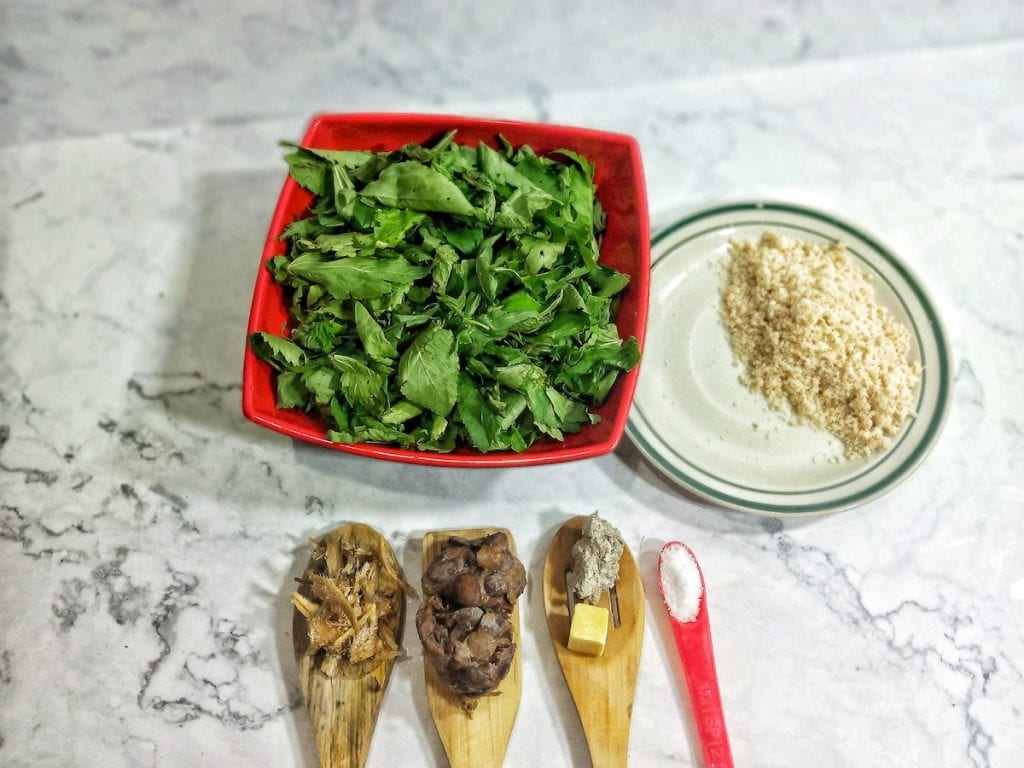
Ingredient Additions & Substitutions For Ewedu Soup
Ewedu
Dried ewedu or ewedu powder can replace fresh or frozen ewedu leaves though the taste and viscosity might be slightly different.
Ground Crayfish
Dried shrimp powder is a good substitute for ground crayfish as it has a similar taste and flavor. The main difference between crayfish and shrimp is their appearance and where they live.
How To Make Ewedu Soup (Step-by-Step)
Ingredients
Fresh leaves
- 8 oz fresh ewedu leaves (jute leaves)
- 3.5 oz ground melon seeds aka egusi (optional)
- 4 cups of water
- 2-3 tbsp locust beans
- 2 tbsp ground crayfish
- 1 seasoning cube
- Salt to taste
Frozen
- 1 pack (8 oz) frozen jute leaves
- 3.5 oz ground melon seeds aka egusi (optional)
- 2-3 tbsp locust beans
- 2 tbsp ground crayfish
- 1 seasoning cube
- salt to taste
Instructions
STEP 1: Add water to saucepan or cooking pot and heat. Add potash (optional).
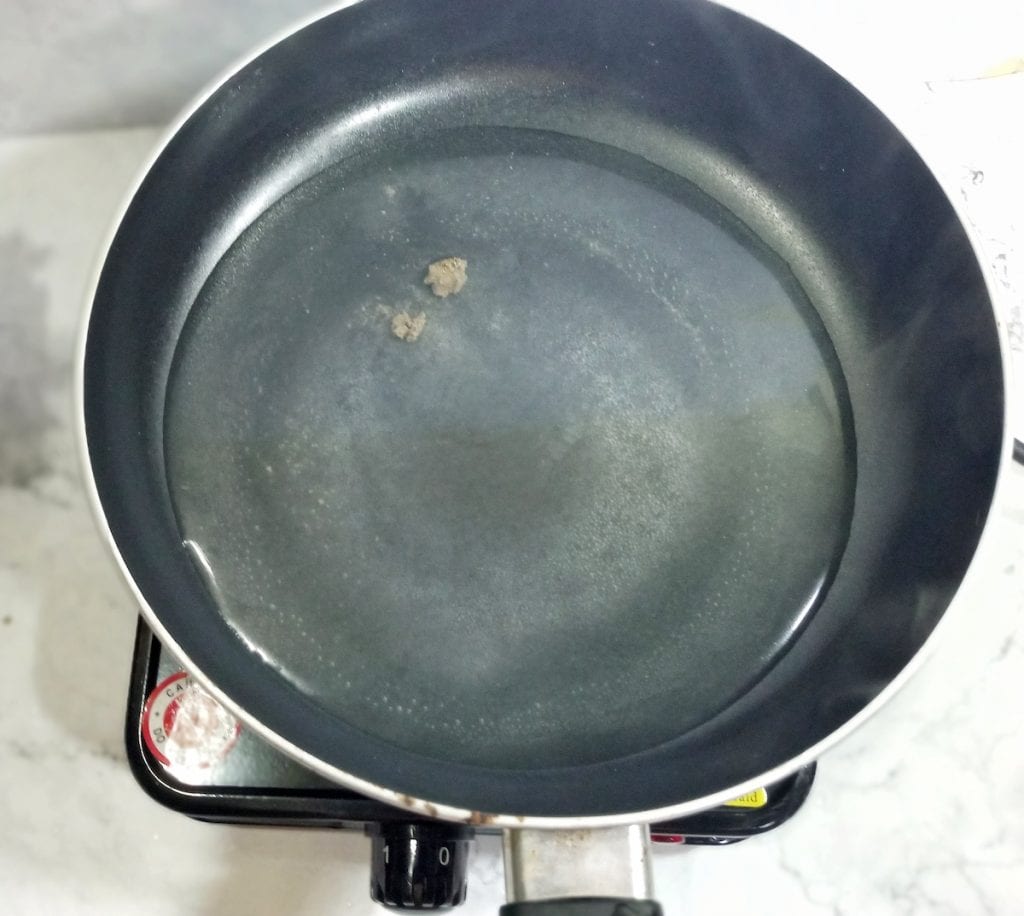
STEP 2: Boil the locust beans to bring out the flavor.
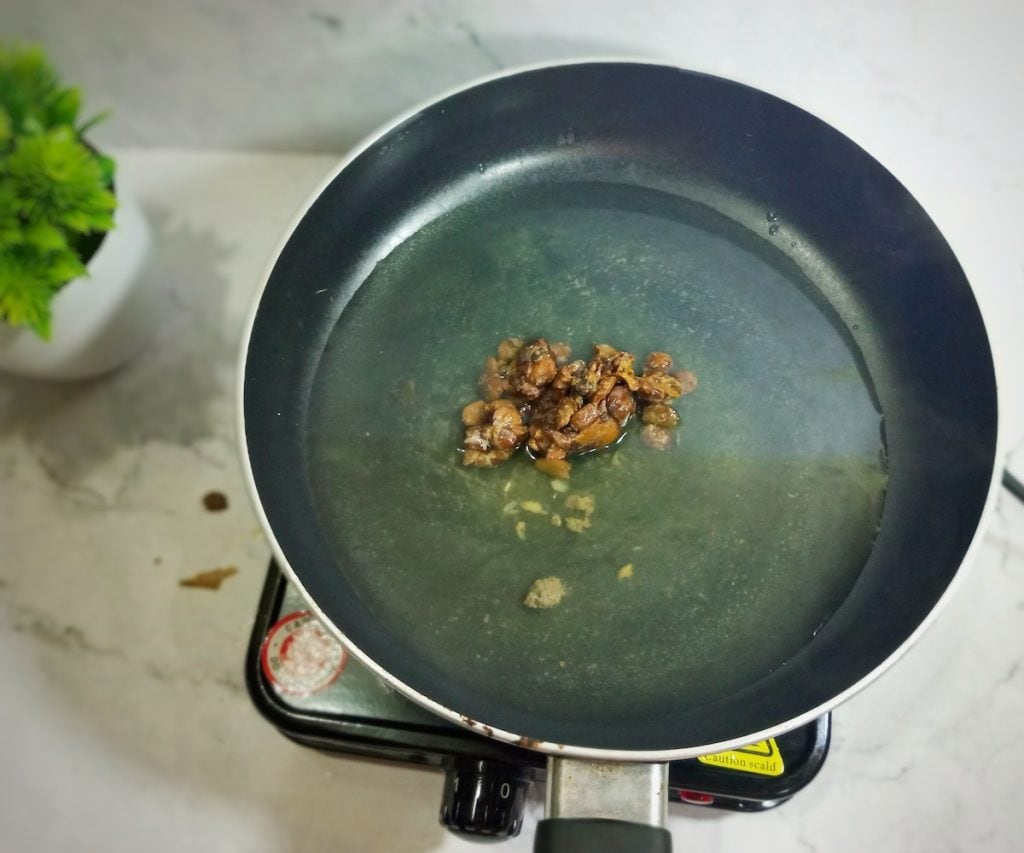
STEP 3: Next, add your pre-washed ewedu leaves and cook on medium heat for about 5-10 minutes.
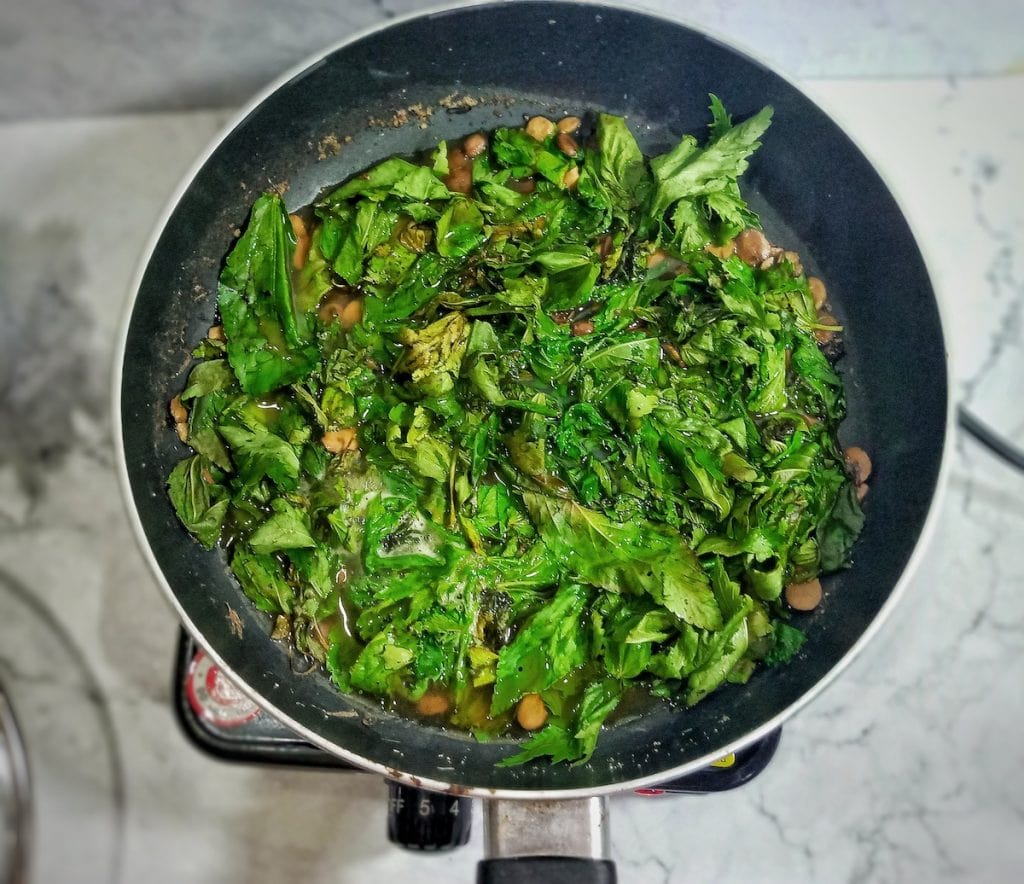
STEP 4: Mix the ground melon seeds (egusi) in a small quantity of water to form a paste.
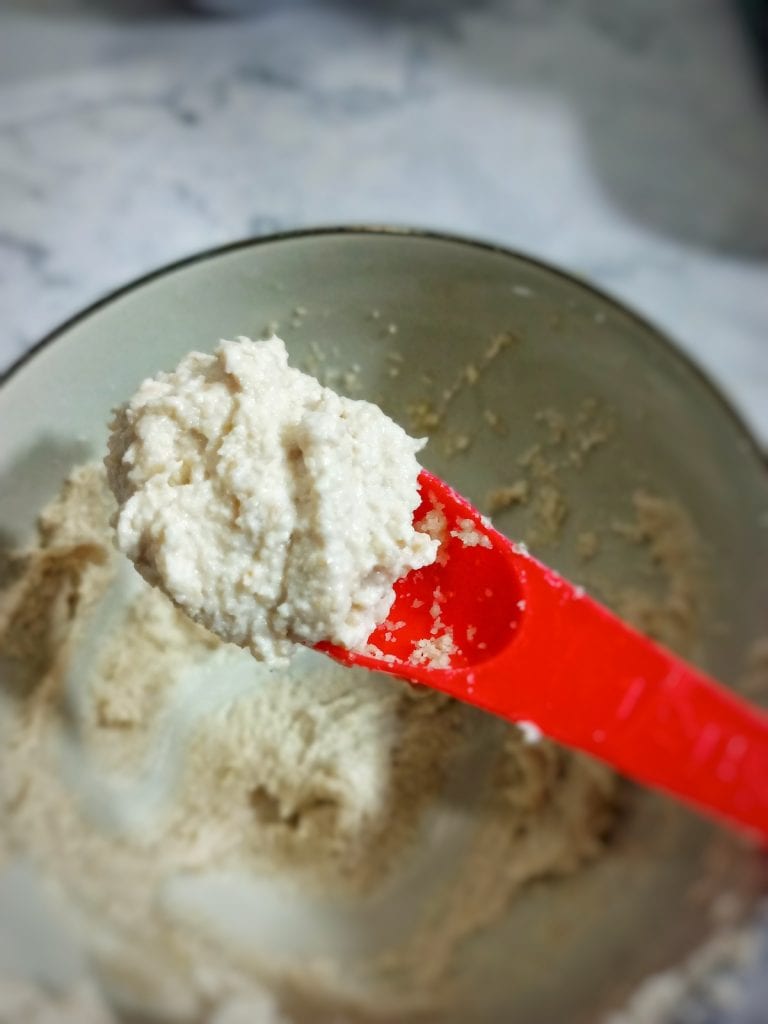
STEP 5: Add the egusi paste to your saucepan in small lumps. Cook for 5 minutes.

STEP 6: Transfer to a blender. Blend until smooth (about 30 seconds).

STEP 7: Transfer the blended mixture back to cooking pot. Add crayfish.

STEP 8: Add your seasoning (salt and seasoning powder). Cook for no more than 5 minutes.

STEP 9: Serve hot with amala or your choice of swallow.
Why Is My Ewedu Not Drawing?
Overcooked Ewedu Leaves
When the ewedu leaves are overcooked, the soup will lose its thick consistency and have an unpleasant taste.
Too Much Water
Adding too much water to ewedu will reduce its thickness and viscosity, thereby preventing it from drawing.
Water does not need to be added to the frozen pack as it comes with enough water in each pack.
What To Serve With This Ewedu Soup Recipe
Traditionally, ewedu soup is served with Nigerian tomato stew and swallow of choice.
The popular sallow to serve ewedu with are:
- Amala
- Fufu
- Eba
- Ewedu soup can also be served with gbegiri (beans soup) for an amazing abula experience.

Tips About Making Ewedu Soup
- Frozen locust beans can be soaked in hot water for 10 minutes and drained before use.
- Extra spices can be added for flavor, but the soup might lose its original taste as crayfish powder is the traditional flavor for the soup.
- Locust beans may be omitted from the dish if you are not a fan of its smell.
- Overcooking ewedu soup will make the soup lose its viscosity, and undercooking it will prevent the proper release of flavors. To avoid this, stick to the cooking time in the instruction above (5 minutes).
- Avoid adding more water to frozen jute leaves for ewedu soup (it usually comes frozen with water already added).
- If your soup is too thick, add some warm water to reduce the viscosity.
- Low to medium heat is the best temperature to cook this soup. Too high a heat will damage the sliminess of the soup.
- Jute leaves can be used as a vegetable thickener for other soups like okra soup.

How To Store Ewedu
Ewedu soup can be stored in the fridge, freezer, or reheated, depending on choice.
Fridge: Ewedu can be stored in the refrigerator for up to 3 days at the right temperature. Before storing, make sure the ewedu has cooled completely.
Freezer: Cooked ewedu can also be stored in a Ziploc bag or airtight container in the freezer for up to 3 days.
Reheat: It can also be reheated in the microwave for about 30 seconds to 1 minute, depending on the quantity.
You can also leave cooked ewedu soup to thaw in the fridge overnight or warmed from frozen when needed.
Can Ewedu Be Taken Raw?
Traditionally, ewedu is cooked before it is eaten. Nowadays, people make it into smoothies and drink it raw.
The smoothie is loaded with lots of antioxidants and anti-inflammatories that are highly beneficial to the body.
Ewedu smoothie can be prepared with four ingredients and four easy steps. Here’s how:
- Thoroughly rinse and add 1-2 handfuls of fresh ewedu to a blender
- Add a Pinch of sea salt (optional)
- Add 2-3 pieces or a teaspoon of cayenne pepper (optional)
- Add 1 cup of water (or as desired)
- Blend until smooth and serve

Is Ewedu Good For Ulcers?
According to a 2015 study, the effect of ewedu leaf on samples of womb muscles of albino rats was found to decrease the amplitudes of its contractions significantly.
This means that ewedu leaves and roots have an antacid activity that makes them a remedy for ulcers.
Ewedu water extract has about 71.33% antacid activity of a drug. Its leaves also contain an ulcer-healing effect similar to an anti-ulcer drug.
Other FAQ About Ewedu
Can ewedu cause miscarriage?
There has been no report of ewedu causing miscarriage in any research. It is safe in pregnancy and contains folate essential for proper brain function and growth in babies.
What is ewedu leaf in English?
Ewedu leaf is called jute leaf in English.
Does ewedu boost ovulation?
Ewedu is believed to help boost ovulation, promote lactation, regulate the menstrual cycle, boost fertility and increase a woman’s chances of getting pregnant.
Is ewedu good for high blood pressure?
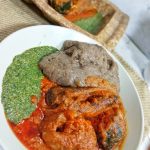
Many articles online claim ewedu can stabilize blood pressure, but there is no scientific research or evidence that supports this claim. Take no chances when it comes to hypertension. Visit a doctor for a proper prescription/treatment for high blood pressure.
What is ewedu seed in English?
Ewedu seed is known as jute mallow in English. It is widely cultivated as vegetable fiber. The seeds are used as a flavoring agent, and herbal tea is made from dried ewedu leaves.
Can I blend okra with ewedu?
In Nigeria, blended okra with ewedu is called ewedu alasepo. This soup is so tasty and natural because it does not need any oil.
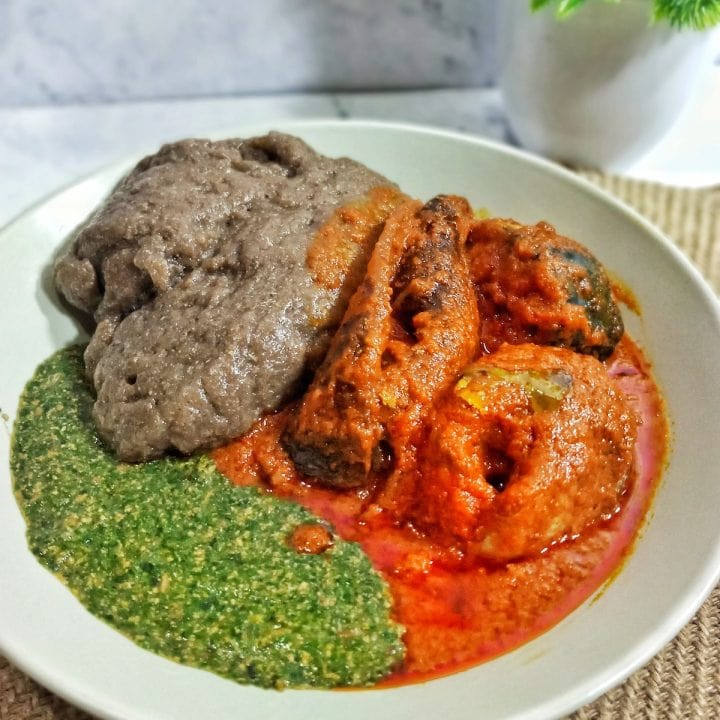
Easy Nigerian Ewedu Soup
Have you ever had ewedu soup? You're missing out on an amazing Nigerian dish if you haven't. Whether you're looking to satisfy your hunger or boost your health, this traditional Nigerian soup is an authentic and delicious choice.
Ingredients
Fresh leaves
- 8 oz fresh ewedu leaves (jute leaves)
- 3.5 oz ground melon seeds aka egusi (optional)
- 4 cups of water
- 2-3 tbsp locust bean
- 2 tbsp crayfish
- 1 seasoning cube
- Salt to taste
- Potash (optional)
Frozen
- 1 pack (8 oz) frozen jute leaves
- 3.5 oz ground melon seeds aka egusi (optional)
- 2-3 tbsp locust bean
- 2 tbsp crayfish
- 1 seasoning cube
- salt to taste
- Potash (optional)
Instructions
- Add water to saucepan or cooking pot and heat. Add potash.
- Boil the locust beans to bring out the flavor.
- Next, add your pre-washed ewedu leaves and cook on medium heat for about 5-10 minutes.
- Mix the ground melon seeds (egusi) in a small quantity of water to form a paste.
- Add the egusi paste to your saucepan in small lumps. Cook for 5 minutes.
- Transfer to a blender. Blend until smooth (about 30 seconds).
- Transfer the blended mixture back to cooking pot. Add crayfish.
- Add your seasoning (salt and seasoning powder). Cook for no more than 5 minutes.
- Serve hot with amala or your choice of swallow.
Notes
- Frozen locust beans can be soaked in hot water for 10 minutes and drained before use.
- Extra spices can be added for flavor, but the soup might lose its original taste as crayfish powder is the traditional flavor for the soup.
- Locust beans may be omitted from the dish if you are not a fan of its smell.
- Overcooking ewedu soup will make the soup lose its viscosity, and undercooking it will prevent the proper release of flavors. To avoid this, stick to the cooking time in the instruction above (5 minutes).
- Avoid adding more water to frozen jute leaves for ewedu soup (usually comes frozen with water already added).
* Recipe adapted from Chef Lolas Kitchen.
Nutrition Information:
Yield: 4 Serving Size: 1Amount Per Serving: Calories: 878Total Fat: 57gSaturated Fat: 8gTrans Fat: 0gUnsaturated Fat: 46gCholesterol: 516mgSodium: 1015mgCarbohydrates: 61gFiber: 7gSugar: 30gProtein: 38g
* Please note that all nutrition information are just estimates. Values will vary among brands, so we encourage you to calculate these on your own for the most accurate results.
Conclusion
Ewedu soup has fast become a favorite dish at Nigerian parties. It is usually served with amala, gbegiri (beans stew), and Nigerian beef stew or fish stew.
Nigerians traditionally serve ewedu soup with very soft amala as weaning food for babies over six months. Its health benefit, as seen above, is endless, and its taste is divine.
This easy recipe is simple to follow and yields a flavorful, aromatic soup that will comfort your soul.

This green soup is a must-try for African soup lovers in search of an authentic Yoruba dish. If you love the viscosity of okro soup, ewedu is right up your alley!
If you’re looking for an easy Nigerian soup recipe that is both authentic and delicious, look no further than ewedu soup.
I hope you liked this easy Nigerian Ewedu Soup recipe. Here are more Nigerian food suggestions for you:


